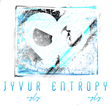Jyvur Entropy's Blog, page 6
October 26, 2021
Love at First Sip: Cover Reveal!
Thirsty takes on a new meaning with nine romantic tales of love and happily ever afters. The spark might begin with a drink, but these relationships develop over many more to come.
From changelings to bounty hunters, shy doctors to Death himself, this diverse blend of stories has all of the right ingredients for everyone to enjoy.
Join contributing authors Jyvur Entropy, Eliza Solares, Alix & Nick Hicks, P. Stormcrow, Dee Rasha, Jordan DeVene, Emerald Aonghusa, and Emily S Hurricane, and you’ll enjoy every last sip of this collection of hopeful romance stories.
Don’t forget to bring a mug or a glass, because each story comes with a recipe sure to put you in the mood for some warm and fuzzies!
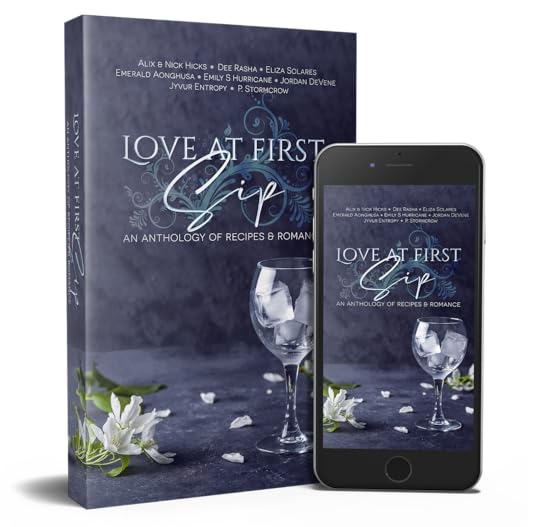
Look at how absolutely gorgeous that cover is! Pixie Stormcrow did a fabulous job with it.
This collection includes a wide variety of romance. It has science fiction, contemporary, paranormal and more. Buy yourself a holiday treat or get some feels for a friend.
Available for pre-order now! Book launches 11/19!
Want to attend the release day launch party? Join contributing authors for live readings, Q&A sessions, trivia, and loads of prizes! We’ll be giving away loads of ebooks and other small prizes. Join The Writer’s Block discord to hang out and attend the stream 11/19 at 1pm EST
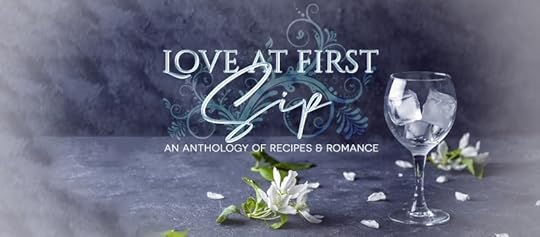
October 23, 2021
Love at First Sip: Cover Teaser
Thirsty takes on a new meaning with nine romantic tales of love and happily ever afters. The spark might begin with a drink, but these relationships develop over many more to come.
From changelings to bounty hunters, shy doctors to Death himself, this diverse blend of stories has all of the right ingredients for everyone to enjoy.
Join contributing authors Jyvur Entropy, Eliza Solares, Alix & Nick Hicks, P. Stormcrow, Dee Rasha, Jordan DeVene, Emerald Aonghusa, and Emily S Hurricane, and you’ll enjoy every last sip of this collection of hopeful romance stories.
Don’t forget to bring a mug or a glass, because each story comes with a recipe sure to put you in the mood for some warm and fuzzies!
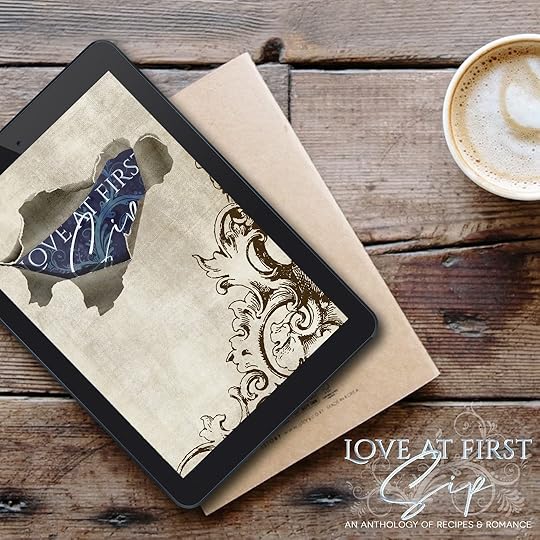
This romance collection is perfect if you want to sample a variety of subgenres. We have alien romance, paranormal romance, role reverse romance, and more!
Available just in time for the holidays, this swoon-inducing collection releases 11/19.
Every story comes with a recipe for a drink, so you can quench your thirst in multiple ways.
Stay tuned for the cover reveal this Tuesday!
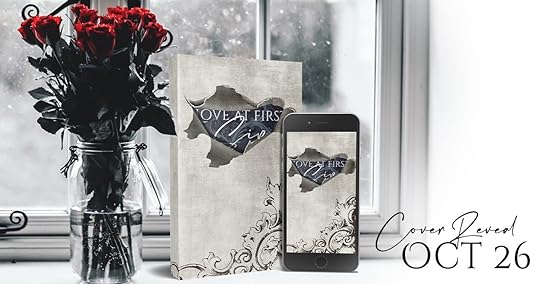
And in the meantime, be sure to add the book to your goodreads!
Writer's Discord for Adults
We do lots of fun events. Next month we'll be holding a launch day party for two anthologies that server members published.
We do writing drop-in hours, video game livestreams, watchalongs, and webinars on all kinds of writing topics.
If you don;t know what discord is, it's social media but you need an invite to join.
Here is your invite! I hope to see some new faces soon :)
https://discord.gg/DrCgFHAw
Secrets: Cover Teaser!
Seven salacious stories guaranteed to sizzle with the promise of whispered secrets and steamy reveals.
From dominant strangers to intimate mistresses, wild west gang leaders to sinister witches, there is something here for every flavor, bound together by one simple fact—a secret. Unwrap these scintillating mysteries layer by layer to reveal delicious confessions.
Join contributing authors P. Stormcrow, E.R. King, Jyvur Entropy, Maria Rush, Alix & Nick Hicks, Lucy Luscious, and Dee Rasha, on the exploration of sensuality heightened by the unknown.
This diverse selection of spicy tales will be sure to stay with you long after you read them.
Y’all have been hearing me talk for the past year about the anthology projects I’m involved with. Those books are finally ready to launch!
Cover reveal coming soon, but here is a teaser for now.
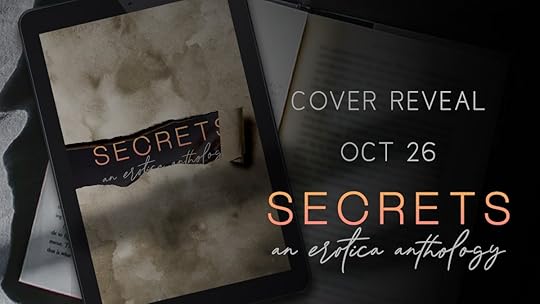
Stay tuned for the cover reveal this Tuesday!
This sexy collection will be available just in time for the holiday season.
Here’s a sample from my contribution Thirsty for a Virgin to tide you over until then!
“Please, say it…”
She gave his bottom another soft slap, not enough to hurt, just enough to elicit that incredibly hot reaction from him. And she got it; he lifted his hips, as if his ass was searching for more, and he moaned, such a soft, needy little moan.
Smack!
“Good boy,” she cooed.
Smack! Smack! Smack!
“I’m so wet right now. I want your cock so badly.”
“I want it…give it to you…” The man was nearly drooling, draped over her lap and thrusting his hips up, his cock still leaking over her tights. So cute.
Smack! Smack! Smack!
His cheeks jiggled and bounced.
Smack! Smack! Smack! Smack!
“Thank you, Autumn! Ahh…”
She pulled her arm back to give him one a smack harder than the others, as a sort of grand finale. In the center of his ass, she planted one last sharp open-palmed slap.
He cried out, lifting his hips again, and digging his fists into the blankets, twisting his fingers in the fabric. He moaned so long and loud, she thought maybe he’d cum, but a peak down between his legs revealed a still dribbling, but very much erect cock.
She reached down between his legs and gently took hold of his shaft. He looked at her, pupils round as saucers, whimpering. He was deep into sub space. She lovingly stroked his cock and fondled his balls.
“Do you like this, my good boy?” she whispered.
“Yes.” Such desperation in his voice. “Yes.”
Squeezing his cock, she asked, “Should we have you turn over, so I can fuck you?”
He moaned and nodded.
“Should I make this,” and here she gave his cock another firm squeeze, “my own personal toy? Should we have you lay nice and still, so I can fuck this cock until I’m good and done with it?”
Book releases 11/19.
If you want to get your hands an arc (that means a free copy in exchange for an honest review) let me know in the comments below! Or join my discord to keep up with all the announcements and be alerted when the arc signups are happening.
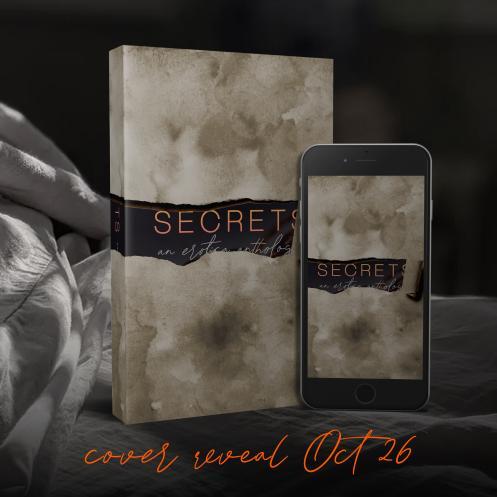
Be sure to add the book to your goodreads!
October 22, 2021
Darcy Coates: Horror with Hope
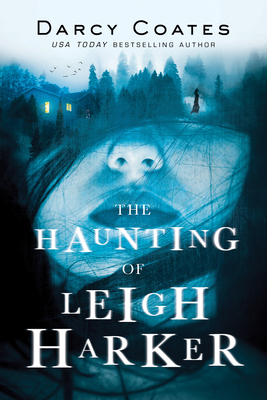
Holy CRIMINEY y’all! How is Darcy Coates not holding a Bram Stoker right now? I think as soon as an author has that common-folk-stank of commercial success, people become blinded to the true merits of their work.
The twists in this book were incredible. Multiple twists that all wove together so well. And I saw none of them coming.
The writing is superb. So emotional and vivid. The descriptions are so gritty and pull you right into the terror of what is happening. More than that, there is a horrifying surreal quality to it. Time stretches and undulates, reality twists into nightmares and back again. What is real and what isn’t? Leigh is stuck in a waking nightmare, a hell she can’t get out of.
And somehow, through all of this terror, through the rattling of the cupboard door and the hands reaching out from under the bed, the sensation of insects writhing in her mouth, and the rot creeping from every crevice of her home; through all of this, the book has a hopeful tone and resounds with themes of love, friendship, and the enduring ties of family. Death is present throughout the book in many ways. Some characters have died. Some characters are close to dying. Some have lost loved ones who have died. Yet, death itself is not the terror in this book. Death is a stage of life that hints of peace and hope. It’s beautiful really. The terror is the evil that lurks in the hearts of human beings, and once that terror is truly revealed, even that is presented with an air of compassion. Evil people are to be pitied, once the imminent fear has passed.
And the most evil people have to suffer the most. They build the hells that they can’t escape, because they can never escape the evil in their own hearts, they can never redo the wrongs they’ve committed.
The ending of this book made me sob.
Literally, there were tears running down my face, on my couch just sobbing. The friendship between the characters was so beautiful.
Darcy Coates writes scary books, but her books are so hopeful and so human, and she deserves so much more recognition than she gets.
This book is fucking brilliant. Just ignore the fact that you probably bought it in the grocery store next to a case of snapple, okay? It’s brilliant.
It should win a Bram Stoker award. I’ve never loved a horror novel as much as I loved this one.
Darcy Coats has replaced Paul Tremblay as my favorite author.
I want to keep buying her books in the grocery store, but I also really want her to be recognized for the absolute legend that she is.
Horror with beautiful themes of love, friendship and family; I’ve never read anything like it.
October 20, 2021
WWW Weds: Scary October Reads!
This is a weekly meme hosted by Sam at Taking on a World of Words.
What Did I Recently Finish Reading?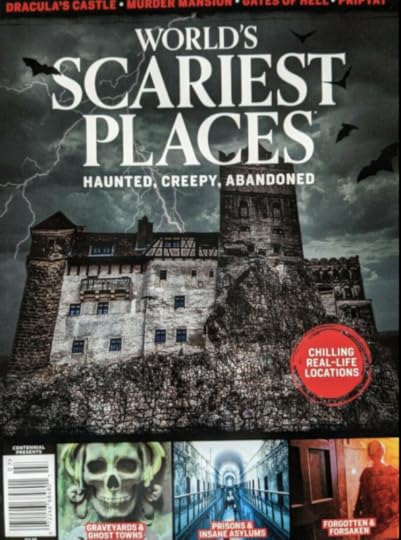
I think I might be the only weirdo who regularly picks up reading material at the grocery store. I did a poll recently in two writer’s discords. I asked how many people buy reading material at the grocery store. Literally everyone except for me said they do not. I guess I’m the weird one lol
But yeah, I love to pick up fluffy stuff to read when I go grocery shopping. Grocery shopping is a chore and it’s nice to have a break in the middle of that chore to flip through paperbacks and magazines.
I recently finished this magazine of scariest places. I think the most interesting place I read about what was sculpture garden of Veijo Ronkkonen.
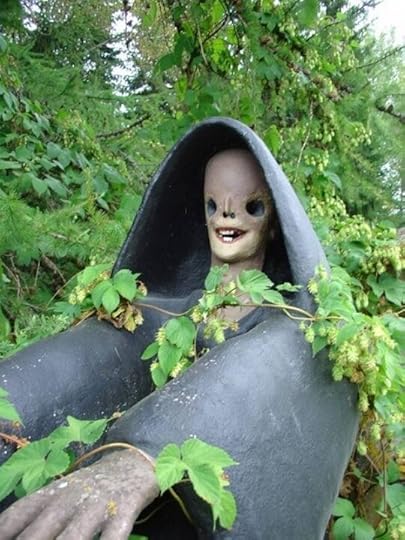
This notoriously shy Finnish recluse spent almost 50 years filling the forest behind his house with these eerie statues with real human teeth.
He never promoted his work and never agreed to lend any of his sculptures to museums or art exhibits.
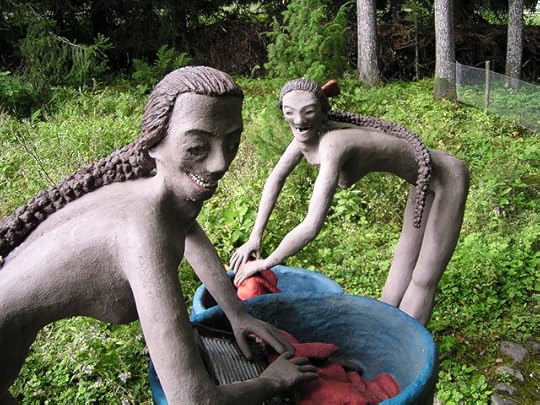

The sculpture garden has almost 500 pieces. Nobody knows where the human teeth came from.
Another book from the grocery store that I just finished is this Darcy Coates haunted house book.
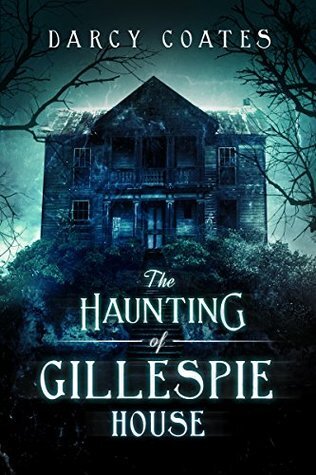
Darcy Coates has a LOT of haunted house books. The general consensus in the book community seems to be that she writes fluffy, formulaic, but perfectly serviceable haunted house books for when you’re in the mood for something spooky but light.

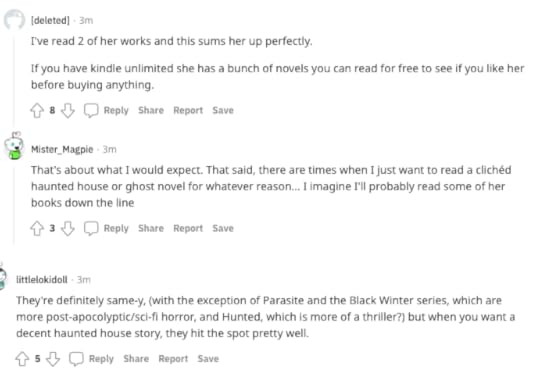
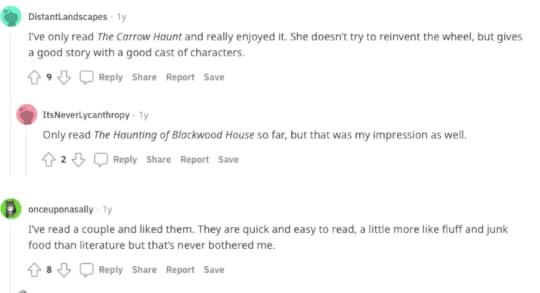
My thoughts are the same. Light spooky story. Classic haunted house, but with the twist of a very happy ending. A lot of people have called her “cozy horror.”
What Am I Currently Reading?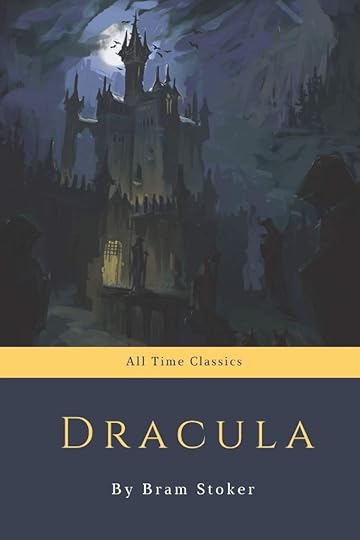
I’m still reading Dracula for a book club that I’m in.
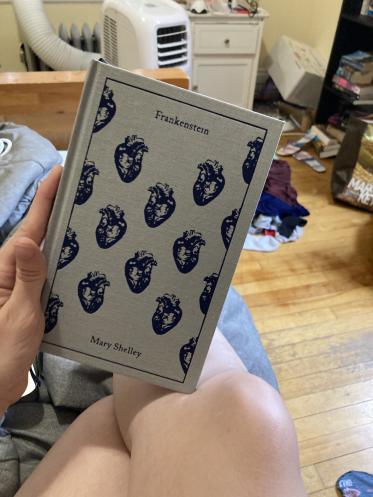
I’m also still working my way through my reread of Frankenstein.
For anyone about to delve into a critical reading of Frankenstein, I recommend researching the following:
-The Enlightment era and the new focus on rationality, empiricism, and scientific discovery.
-The tension between science and religion during the Enlightenment era
-Galvanism: particularly the experiments of Galvani
-Naturalist philosophy: especially the role of nature in transcendence and the sublime
-Percy Bysshe Shelley and Lord Byron’s views on vegetarianism (Shelley has an essay on this topic). You see vegetarianism make an appearance in Frankenstein as the monster talks about her meatless diet.
What Will I Read Next?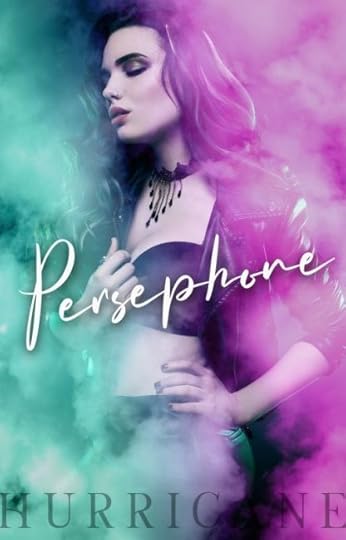
I started this a while back and really need to get back into it! This is a wattpad story about a hot mess of a character. You can read it for free on Emily Hurricane’s profile here.
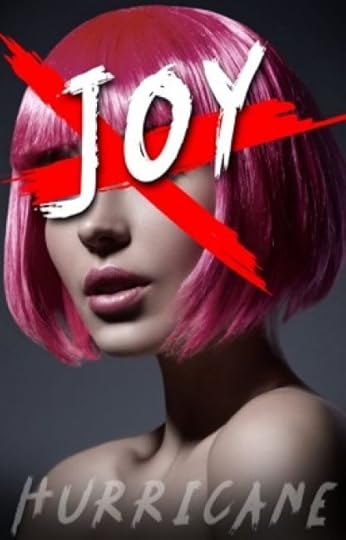
And I’ve been meaning to read this one for ages! It’s a buddy cop story with a Manic Pixie Dreamgirl character archetype that is actually a manic pixie! XD I love that idea. That’s also up on wattpad.
That’s it for me! What are you reading this week?
October 19, 2021
Psych Patients Will Never Get Proper Care as Long as There is a Profit Motive
And for some reason, this is an issue a lot of people don’t want to talk about. I don’t know why. I don’t know why people so badly want to derail a conversation about what changes need to be made to ensure proper treatment care, by talking about their own positive experiences with therapy.
It happens every single time I bring this up.
Me: ‘70% of the doctors on the board of the DSM 4 received money directly from pharmaceutical companies. One of the doctors receiving money from Risperdal-a medication approved by the FDA to treat bipolar in kids-lobbied to expand the diagnostic parameters for bipolar and “educated” his fellow doctors on how to spot bipolar. As a result, there was an epidemic of children misdiagnosed with bipolar between the late 90s and 2005. This is just one example of how pharma influences doctor education, research, and the standards of patient care at every level.’
Well-meaning people with weird blinders on: ‘But therapy was so helpful to ME and my family members! You can’t say it never helps anyone!’
Me: ‘I’m not….I never once said that….I’m talking about a conflict of interest and a profit motive that compromises patient care and leads to severe human rights violations. It’s weird as hell that you’re so resistant to talking about this.’
Some people I really like and respect have done this. I’m just having a hard time understanding why otherwise smart and kind people don’t care about this issue.
You can feel positively about therapy and also want to end the conflicts of interest. Why wouldn’t you want to? Why on earth would you want corporations to have MOST of the say in patient treatment?
This is an issue that every mental health ally needs to be talking about.
I’d love to form a group of like-minded people who are passionate about this and want to spread awareness about this issue. I’m not gonna lie: I don’t have high hopes for interest in this. The apathy is real.
But if you care about ending the financial conflicts of interest between pharma and doctors: here is a discord server https://discord.gg/rd73mm9m
October 16, 2021
Mental Health Reform is Severely Needed
When I was 14 I was diagnosed with bipolar. I was hospitalized, medicated, and put into therapy. Once I had that label, everything I felt and did was because I was bipolar. My house was very chaotic and violent. My mom ran a sex toy shop and the house was filled with porn and vibrators. There was a constant stream of my mom’s friends and boyfriends, strangers, through our house and through my life. My stepdad (my younger sisters’ dad) had moved out four years prior and ever since it had happened, I’d been reminded by all of the adults in my life that the only man who’d ever been a father figure to me wasn’t actually my dad. Mom was always trying to get me to stay home instead of going to visit him on the weekends with my sisters. She even lied to him several times that I didn’t want to go, then came back to me and said “Jose doesn’t want you to go on Sunday. He thinks it’s weird you want to go. You aren’t his kid.” And then there was the constant screaming, being slapped, kicked, punched, etc.
But none of that mattered. None of that was explored.
I was bipolar.
I was given drugs.
None of the stress and chaos in my life was a factor in my erratic and abnormal behavior. I had a chemical imbalance.
Under the biomedical model of mental health treatment, social/environmental factors are barely considered. Even when they are considered, they are always secondary to the “brain illness” theory.
I went to therapy, sure. And a nice Christian woman, who had named both her tropical fish after Biblical figures, would smile and nod while I rambled on about the bands I liked and the kids at school and all the fights I was having with my mom. I let her read my poems once. Many of these were rife with someone-please-notice-my-pain overdramatic suicidal ideation. Back then, I had a fantasy of starving myself to death and I flirted with binging and purging, but never had the discipline to really stick with it. I had vivid daydreams of an open casket funeral where my family would have to stare down at my emaciated form and say, “We shouldn’t have yelled and been mean and hit her. Look at what we did to her.”
When I was diagnosed bipolar, it felt like I was being told that everything was my fault. I was defective. My brain didn’t work properly. And of course, my family members loved to use the word “bipolar” as a weapon against me.
None of my feelings were valid. It was like I wasn’t even human anymore. Everything I felt was because of my brain disease.
I was angry at all of the adults in my life for the physical and emotional abuse and the professionals always seemed to be saying, “All of that is irrelevant. This is a separate issue. Your brain is defective. If your brain wasn’t defective, you wouldn’t even be so angry about all of that.”
Because I felt so entirely dismissed and judged by these professionals, they really only ever heard the tip of the iceberg with the abuse in my house. I tested them, tried to figure out if I could trust them, and when they always circled back to this label, this accusation, I threw my walls up.
Labels are otherizing. Labels are a judgement. Labels hurt. You can not hurt people and then expect them to let all their walls down and be incredibly emotionally vulnerable with you. Therapy didn’t do anything for me because of this. I wasted a lot of time talking about nothing. Because I was afraid to say anything real. Those professionals kept me so on edge and made me feel so small.
Now, a lot of the time, when I criticize therapy and talk about the deeply-ingrained systemic issues, well-meaning and kind people who simply have blinders on will argue with me using anecdotal evidence. They talk about therapy helped them or someone they know, and ignore the fact that patient treatment is built on a flawed model from the ground up.
I also have to ask: when people talk about their bad experiences with the police, or talk about ways that policing could be improved, do you pop up to talk about how you or someone you know was helped by the police?
Just because therapy helps middle-class white people with mild mental health issues and resources, that doesn’t mean therapy helps the most vulnerable people: the homeless, the people with psychosis, the low-income and POC patients, and children.
It’s getting very exhausting dealing with people derailing conversations about the systemic problems with therapy to spout anecdotal evidence. Anecdotal evidence very much colored by their socioeconomic status, race, and severity of mental illness.
Back then, I didn’t know exactly why I hated being labeled bipolar so much. I just did. I could admit there were problems with my behavior and I could admit that I struggled to regulate my emotions. I could admit those things and was willing to work on those things. I just didn’t want to be bipolar.
I believe that one word “bipolar” kept all of the doctors, therapists, and mental health professionals who dealt with me from looking any deeper. There was no reason for them to try to figure out why I was angry, why I couldn’t control my emotions, why I was disruptive in class and threatening suicide. There was no reason for them to look for a reason; the reason was a chemical imbalance. So as a teenager, they didn’t help me escape my abusive home situation. They didn’t even give me tools to cope with it. They gave me drugs. With the biomedical model of mental health treatment, drugs are the only logical answer. Drugs are the only hammer worth swinging at a problem believed to be caused by a chemical imbalance.
Not only do these labels stigmatize, prevent patients from getting to the real of their problems, and lead to the prescription of superfluous drugs which may harm them (the “side” effects produced by SSRIs and antipsychotics lead to an enormous drop in quality of life and may even lead to lifelong disability (akathisia) or death) but to really put the cherry on top, these diagnostic labels may not even be scientifically sound. In fact, there is a plethora of evidence that these labels are not based in scientific fact.
The book that doctors use to diagnose patients is the Diagnostic and Statistical Manual. The DSM is published by the American Psychiatric Association, which is a lobbying group (. This is the book that doctors use to diagnose psych patients. The DSM has “a nearly hegemonic status as the reference for the assessment and categorization of mental disorders of all types – not only in the United States, but increasingly in Europe and more recently Asia (Kawa).”
The majority of doctors on the boards of both the DSM IV and DSM V received money directly from pharmaceutical companies. It’s very easy to see how these egregious conflicts of interest directly influence the DSM itself. Allen Francis explains in a Wired interview that the diagnostic labels in the DSM are “making diseases out of everyday suffering and, as a result, padding the bottom lines of drug companies (Greenberg).”
Allen Francis was the lead editor of the DSM IV and he admitted that psychiatric diagnosis is about as far from an exact science as it gets. He is actually quoted saying, “there is no definition of a mental disorder. It’s bullshit. I mean, you just can’t define it (Greenberg).” That’s not exactly heartening to hear. Although it’s not very surprising when we remember some of the very normal and healthy human behaviors that have been clinicalized/pathologized in the past. It wasn’t very long ago that homosexuality was one of the labels in the DSM. Yet for some reason, the majority of people don’t question the DSM today. The methods for creating diagnostic criteria haven’t changed much. In one of her many lectures on the topic, Paula Caplan explains that a great deal of creating diagnostic criteria is simply doctors sitting around a table and going with their gut. Premenstrual Dysphoric Disorder was thought up by two men on a fishing trip. They engaged in the facade of research. They created a checklist of symptoms and gave it to several groups of people. One of these groups was a group of men. There was no significant difference in how any of the groups answered these research surveys. Obviously a pre-menstrual illness is not something that cis-men can suffer from. Yet this was ignored, PMDD entered the DSM, and prozac was rebranded as Serafem. Many of the women prescribed this drug with all of its hyper-feminine, pretty pink packaging, never even knew that what they were taking was prozac (Gottstein).
Using the DSM as their primary guide, mental health professionals look at every patient, not as a human being with complex psychological mechanisms and learned behaviors and coping skills that-while unhealthy-may be reasonable given the context of the patient’s life and past traumas, but instead as a cluster of symptoms. Within the biomedical framework and with the DSM in hand, an adolescent who is angry and acting out is not possibly displaying an appropriate reaction to trauma and a chaotic or unsafe living situation; they are bipolar. Give them a pill. Shut them up. Balance their mood. Teach them they deserve whatever is happening to them and that they are ill if they can’t cope with it. Teach them they deserve abuse. What else would drugging up traumatized children possibly teach them?
And this doesn’t set children up to move past their trauma in a healthy way. It sets them up perfectly for trauma reenactment as an adult. It is a terribly harmful system.
There isn’t even enough evidence in favor of the biomedical model to justify using it as the primary framework for mental health treatment. In fact there is a lot of evidence that the chemical imbalance theory, the basis of the biomedical model (and the justification for using all of these diagnostic labels) is entirely wrong. As Irving Kirsch explains in his book The Emperor’s New Drugs: Exploding the Antidepressant Myth, “From the beginning, the chemical-imbalance theory was based on weak and contradictory evidence, and data contradicting it were simply ignored…A half-century of research has produced data indicating that the chemical-imbalance theory must be wrong (Kirsch 82).”
It’s interesting to note that the first antidepressant was invented before the chemical-imbalance theory was ever posited. The first antidepressant was iproniazid. It was created in 1951 for the purpose of treating tuberculosis (Kirsch 83). For whatever reason, whether it was the placebo effect or improved quality of life due to reduced physical suffering, patients in the initial drug trials reported feeling happier and having a greater overall sense of well-being.
The drug was invented before doctors ever had any idea of depression being caused by a chemical imbalance. I find it highly suspect that a drug was accidentally discovered to have an effect on depression and then a scientific theory of the root cause of depression followed. It is my belief that a profit motive incentivized the creation of the biomedical framework, a framework that greatly harms mental health patients. Ethan Watters explains in his book about the Westernization of mental health treatment worldwide that in countries that use either a spiritual or psychosocial model of mental health, patients have far better outcomes, particularly when it comes to psychotic illnesses such as schizophrenia. He refers to this as the “most perplexing” piece of data we have on schizophrenia, that “people with schizophrenia in developing countries appear to do better over time than those living in industrialized nations (Watters 137).” If we consider how dehumanizing the biomedical model is, this really isn’t perplexing at all. While so many mental health activists bemoan the fact that so many people don’t have access to Western mental health treatments, I’d say they are missing something key: they are missing that Western mental health practices harm more than they help. They set people up to fail. That is why so many patients end up labeled “treatment resistant.”
My solution to help children with emotional issues is simple: ditch the labels. They harm far more than they help. Identify the behavior itself rather than lumping them into a symptom pool which only exists to meet the profit motive of pharmaceutical companies.
There is no reason why professionals can’t take the extra time to distinguish individual behaviors and potential antecedents, rather than sloppily throwing a harmful label onto children and funneling them into a system that will teach them they are defective because they reacted to trauma, damage their self-worth, and make it all the more likely they never overcome whatever it is they are struggling with.
I used to work in a special education program and I’ve seen my fair share of IEPs. An IEP (or ‘Individualized Education Plan’) includes a label. For the program that I worked in, that label was almost always autism, because I worked in a specialized autism program.
Here are just a few things that were actually said to me by teenagers who had been given the autism label:
“I can’t help it. I have autism” (A child who was being disruptive in class and destroying classroom property).
“I won’t get married when I grow up. I’m autistic.”
“Are we going to sit with the normal kids on the field trip?”
“I’m not smart. Autistic kids aren’t smart. I didn’t talk until I was eight. I’m stupid.”
I’m somewhat torn when it comes to labels and autism, because many autistic people are proud to be autistic and consider it a large part of their identity. But it would be disingenuous for me to not point out how harmful that label was to the confidence and self-image of many of the kids I worked with.
I have to think; could we have given them the services and help they needed without a label?
In public education, the answer is probably no. Everything must be documented to ensure kids receive the help they need and that documentation comes with a label.
Unfortunately, it means that many kids who do not even fit a label end up being given it, simply so that the school can better meet their needs. In the school I worked in, we had a number of students who needed a more specialized class program. One was a traumatized child who had been kept out of school from some time and bounced from one foster home to another. She was fifteen and could not read. Her IEP included the phrase “autism spectrum disorder”, yet it was an open secret that this girl did not have autism. She simply couldn’t be put into the general education classes, because of both academic and emotional challenges. The label was necessary to get her the individualized instruction she needed.
So when labels can not be ditched entirely, I think it’s pertinent to treat the children as individuals first and foremost. Treat them as human beings with complex emotional and academic needs. There’s no reason to reduce them to a label (which happens far more than it should, from what I have seen of K12 education).
There are a few other changes that could be made to K12 education to improve the mental health and emotional well-being, not only of children who have been diagnosed, but of all children.
I want to take a second to consider the secondary education setting. Kids have somewhere between 5-10 teachers, depending on the school and classes they are taking. Every 40-60 minutes, they get up, collect their belongings, and walk through a maze of crowded and noisy hallways. They have no time for deep learning or reflection. They are in a constant state of transition; class is forever either starting or ending. Eight or nine times a day they are moving through a swarm of bodies, bombarded by noise and nonsense.
In what other situation would a human being live this way? In elementary school, kids remain in the same classroom for much of the day, maybe leaving two or three times for lunch and special programs. As adults in the workplace, we get to work and for the most part, remain in the same place all day. Even when I worked as a retail cashier, I might have moved from one register to another, but I mostly remained in the same general area.
We ask middle and high school students to live in a way that is not expected of anyone else. Even in college, students usually have only three or four classes in a single day. Secondary students in K12 education transition almost ten times a day. Some schools have a rolling block schedule that cuts down somewhat on transitions. For the most part though, students are transitioning far too often. They have no time to settle in, to feel connected to their surroundings or build a classroom community. They have limited opportunities to relate to their teacher or find a mentor/role model. They are in a constant state of flux, not truly connected to anything. This isn’t a natural way to spend half of a human being’s waking hours.
Student mental health could be greatly improved by lumping subjects together (math and science in one cluster, English and history in another) and having the same teachers instruct multiple subjects, so that the students can transition far less often.
With teachers spending more time with the same students, mental health or behavioral challenges could be identified and dealt with more quickly.
I’d also like to suggest that when a student is struggling that we don’t rush to get them labeled and funneled into the very harmful mental health system. There is a more human way to help them. Instead of pills that will greatly detract from their quality of life through a combination of lowered self-confidence/self-worth and terrible side effects, why not encourage kids to join clubs, go out for sports teams, or volunteer in their communities?
When I was a teenager, I actually experienced both. I was put on powerful drugs (some of which I now know had the potential to cause me debilitating and even life-threatening side effects) and I volunteered in my community and was active in clubs at school. I took depakote, prozac, and zyprexa, and I also helped out at my local library every Saturday morning. This was in the early 2000s and my library was in the midst of switching from a physical card catalogue to a digital system. My rural NH town had only one librarian and putting every single book into the digital system was time intensive. So I helped out with that. I was also a Big in the Big Brothers Big Sisters program and hung out with a third grade girl every Friday afternoon. Volunteering and writing for my school newspaper kept me busy and was great for my mental health. Much better for my emotional state and sense of self-worth than the pills that gave me tremors and sleep disturbances or the therapy sessions that made me feel unheard and judged.
Am I saying pysch drugs or therapy are always bad and never work for anyone? No, not at all. But because they have the potential to greatly harm, they should not be the first tool we reach for. There’s a plethora of evidence that funneling a kid into the mental health system will have a negative impact on them for the rest of their life. The mental health system runs on a profit motive, and therefore often marginalizes and harms the vulnerable people it is meant to care for.
So why introduce children to something potentially harmful, why subcontract basic human compassion? Why label traumatized or struggling children as “chemically imbalanced” and drug them up?
Why do any of this, when there are so many other compassionate and holistic resources at a school’s disposal?
Humans need community, connection, a sense of purpose, and solid role models to guide them. These are all things that a caring school can provide, without referring children to “professionals.” Those professionals have been corrupted in a number of pervasive and insidious ways by pharmaceutical company money, and so they are likely to put children on powerful drugs, when really all that child really needed was to be heard, understand, and guided towards some positive coping tools.
Reject labels, or at the very least decentralize them from your understanding of a student. We live in a hyper-individualistic society that loves quick fixes. Reject this. Invest in your students. Have real compassion for them. And when a student is struggling, resist the urge to foist the kid off onto the mental health system. By doing this and fostering a positive and supportive school environment, teachers and administrators can do so much more than a diagnostic label ever could.
Works Cited
‘Financial Statements as of December 2019.’ 2019 IRS Form 990. The American Psychiatric Association, Financial Information. https://www.apa.org/pubs/info/reports/2019-form-990.pdf p. 43.
Gottstein, Jim. “‘There are No Rules About Psychiatric Diagnosis-And That Must End!’ Paula J. Caplan, NARPA 9/4/14.” Youtube. 4 March, 2015. https://www.youtube.com/watch?v=tgilB…
Greenberg, Gary. “Inside the Battle to Define Mental Illness.” Wired. 27 December, 2010. https://www.wired.com/2010/12/ff-dsmv/
Kawa, Shadia, and James Giordano. “A brief historicity of the Diagnostic and Statistical Manual of Mental Disorders: issues and implications for the future of psychiatric canon and practice.” Philosophy, ethics, and humanities in medicine : PEHM vol. 7 2. 13 Jan. 2012, doi:10.1186/1747-5341-7-2
Kirsch, Irving. The Emperor’s New Drugs: Exploding the Antidepressant Myth. Basic Books, New York, 2009.
“Sarafem.” RxList. 29 Dec. 2014. https://www.rxlist.com/sarafem-drug.htm
Watters, Ethan. Crazy Like Us: The Globalization of the American Psyche. Free Press, New York, 2010.
The Dia de los Muertos Book Tag
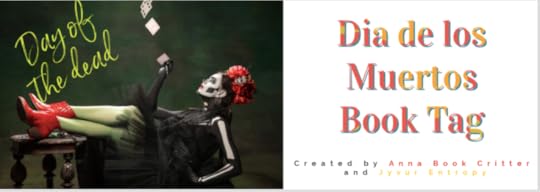
I created this tag with Anna Book Critter. Everybody is welcome to do this tag, just please link back to both of our blogs 
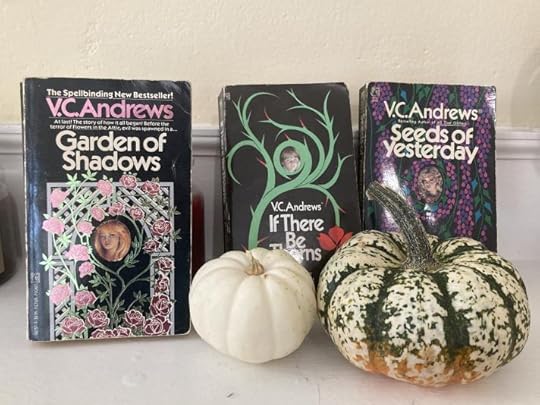
I have to go with the Flowers in the Attic series by V.C Andrews. It’s such classic Southern Gothic, perfect for a spooky autumnal read.
The series follows the entire family. It’s the best intergenerational series I’ve ever read. Books one and two follow Cathy and Christopher (and their younger twin siblings in book one) and the main antagonists are their mother and grandmother. Then book three follows the children of Cathy and Christopher. Book four follows the the children and grandchildren of Cathy and Christopher. And then there’s the prequel Garden of Shadows, which is set in the POV of the antagonist grandmother of Cathy and Christopher.
The whole series is creepy and emotional and heart-wrenching. I highly recommend for so good, classic pulp-y Southern Gothic.
Dia de los Muertos is an important Mexican holiday. Name a book that takes place in Mexico or includes Mexican culture.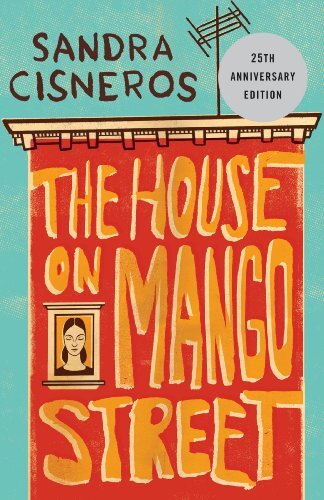
I read this book in both high school and college and really loved how heartfelt it was. It’s a quick, vivid read and I highly recommend it.
This holiday is often celebrated with vibrant, colorful imagery and sugar skulls. Name a book with a cover as visually-interesting and colorful as a sugar skull.I love the cover of Emily Hurricane’s wattpad book Persephone.

I love all of the brightly-colored smoke. The cover is absolutely beautiful. You can read the book for free here.
Food is an important part of the Dia de los Muertos celebration. Food is set out on altars for the spirits of departed family members. Tell us a book where food really makes the story!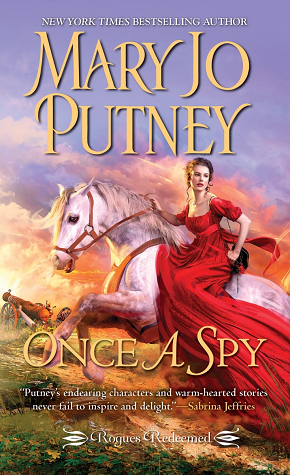
I wasn’t a great fan of this book for a lot of reasons (in fact, I DNF’d at about the 3/4 mark), but the food was a fun part of the story. As the MC and her fiance travel across the country, they eat all kinds of delicious European food. There were many descriptions of buttery croissants and delicious French treats.
Dia de los Muertos is not only celebrated in Mexico, but also in Central and South America. Name a book that takes place in Central or South America or has a Central or South American author.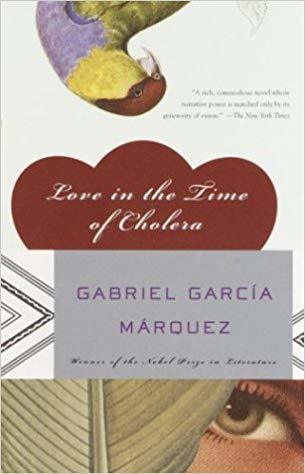
I’ll have to go with this well-known classic. I read it a number of times in both high school and college. It’s not one of my favorites, but there are some strong elements of the writing, and I can see why so many people like it.
In addition to sugar skulls, flowers and butterflies are also symbols of this holiday. Tell us a book with flowers or butterflies on the coverI’ll have to show off this beautiful copy of Persuasion that my Aunt bought for me a couple of years ago.
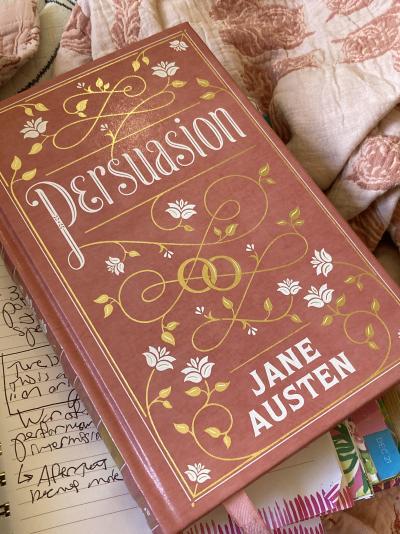
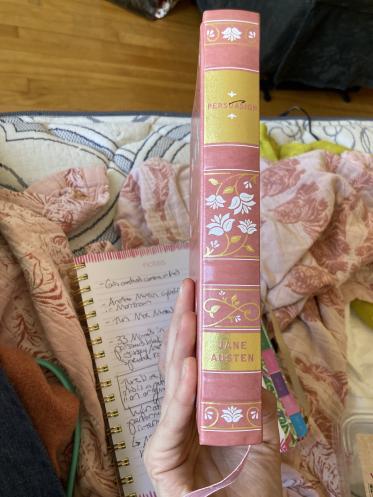
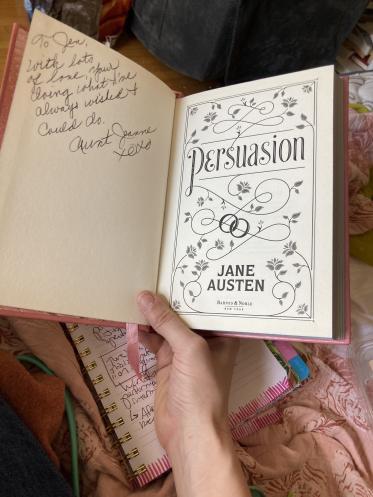 The Day of the Dead is about celebrating life. Name a book that celebrates life.
The Day of the Dead is about celebrating life. Name a book that celebrates life. 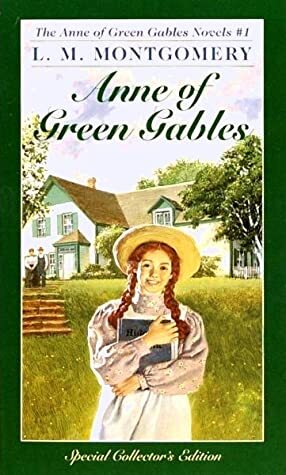
I love this book so much. I read for the first time when I was 11 and last year I reread it. Anne is such a vivacious and optimistic character. She’s so fun to read about. The entire book just makes you feel so hopeful about life.
It is also a day of remembering loved ones who passed on. Name a book that was either given to you or reminds you of a loved one who passed away.When my uncle died in a car crash about 13 years ago, I received a bunch of his old belongings. Mostly fantasy novels, D&D stuff, and a couple of model airplanes.
Some of the books that his wife gave me to remember him by were his Lord of the Rings books, which he really loved.
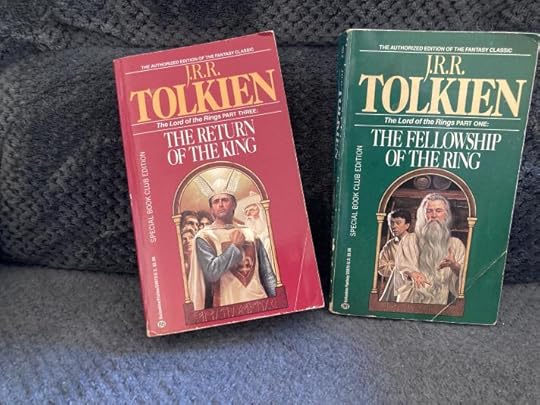 El flor del Muerto – The flower of the dead. Marigolds are used in massive quantities on the Day of the Dead. These flowers represent the sun and rebirth. Also believe to guide the spirits back home. Name a book about rebirth.
El flor del Muerto – The flower of the dead. Marigolds are used in massive quantities on the Day of the Dead. These flowers represent the sun and rebirth. Also believe to guide the spirits back home. Name a book about rebirth. 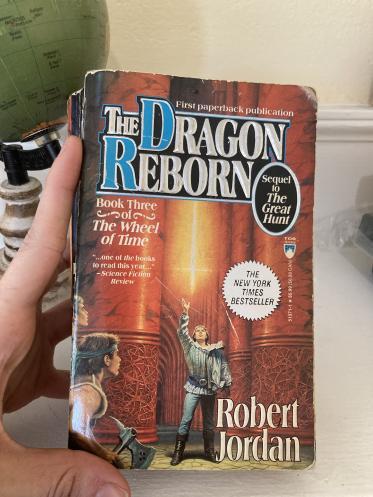
I’ll go with the third Wheel of Time book! The one all about the ‘Dragon Reborn.’ This is the book in the series that I’m currently reading.
Colors are used as a form of symbolism in the decorations and sugar skulls. Some of the colors used in association with Dia de los Muertos are yellow (unity), white (hope and purity), red (blood and life), purple (mourning), and pink (happiness). Take a photo of some book spines in the Dia de los Muertos colors!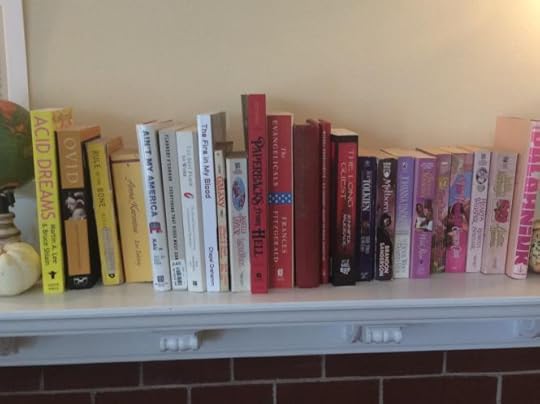
That’s it for this tag! Thanks to Anna Book Critter for working with me on it! You can check out her post here
And a happy Dia de los Muertos to all who celebrate 
Anyone who feels like doing the tag, feel free to snag the questions for yourself and you can put a link to your post in the comments below 

